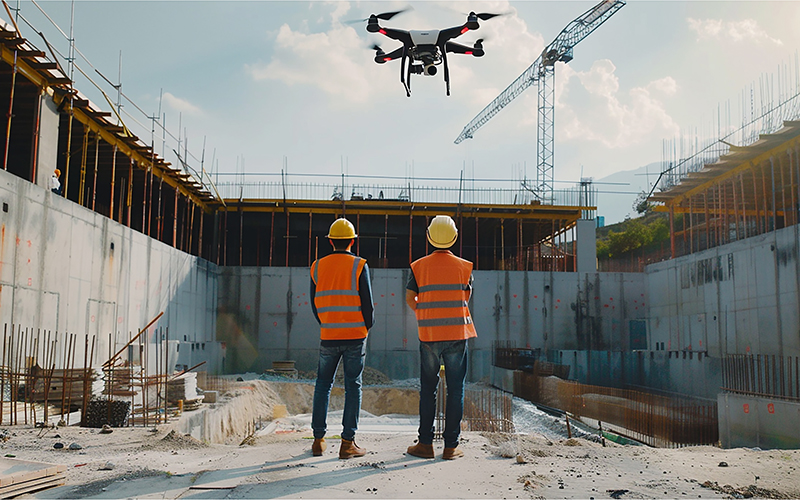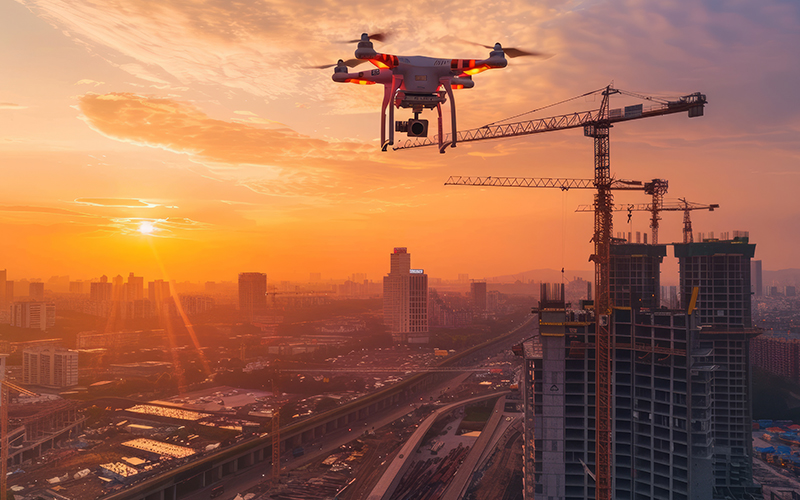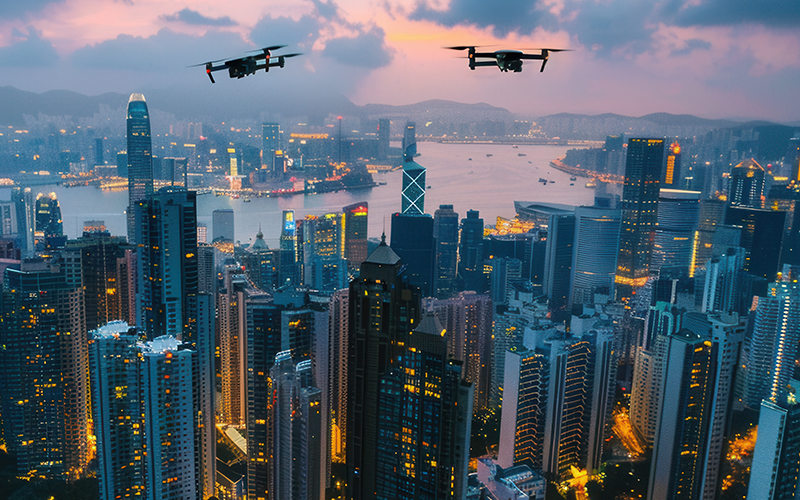Revolutionising Construction: The Drone Effect
Companies must invest in continuous training and development for their teams to fully capitalise on latest advancements.

By Fourth Leap Team
In the rapidly evolving construction landscape, drones have emerged as a game-changing technology, transforming every phase, from pre-construction planning to site safety and legal compliance. This special feature delves into drones’ multifaceted impact, highlighting their pivotal role in modern construction practices.
Drones have redefined pre-construction planning by offering unparalleled precision and efficiency. These aerial devices streamline surveying processes, providing detailed and accurate data far faster than traditional methods. The comprehensive aerial imagery and topographic data captured by drones enable construction companies to conduct thorough land assessments and site analyses with remarkable speed and reduced costs.
Traditional surveying methods often involve significant time and resources, with surveyors having to traverse the site to gather data physically. This takes considerable time and increases the risk of human error. On the other hand, drones can cover large areas quickly and with great precision, capturing high-resolution images and generating detailed maps that facilitate better planning and decision-making.
Moreover, drones enhance the tendering process by integrating detailed maps and ongoing condition assessments into project proposals. This level of detail allows for more precise and compelling bids, facilitating rapid and informed decisions regarding land use and project feasibility. The ability to provide potential clients and stakeholders with a clear and accurate view of the project scope and potential challenges before the ground is broken gives construction firms a competitive edge.
Drones also contribute to environmental conservation and safety by minimising the need for human presence in hazardous or inaccessible areas, reducing the risk of accidents during the survey phase. By decreasing the number of times surveyors and other personnel need to visit a site, drones help reduce the carbon footprint associated with travel. This shift towards drone-assisted planning represents a significant move towards more sustainable, efficient, and safer construction practices.

Key legal considerations include data privacy, airspace regulations, and liability.
Monitoring and Managing Progress
As construction projects become complex, the demand for precise and timely monitoring increases. Drones provide essential real-time updates critical for maintaining project timelines and budgets. Their bird’ s-eye view offers comprehensive overall progress tracking against initial plans, allowing project managers to swiftly identify deviations and make informed decisions, thereby avoiding costly delays.
The integration of drone technology in construction monitoring has been a game-changer. Drones are particularly effective in managing large-scale projects, quickly covering extensive areas and delivering high-resolution imagery. This capability ensures all construction phases align with architectural plans, safeguarding against financial overruns due to unexpected delays.
Furthermore, drones facilitate improved resource management. They provide detailed views of difficult-to-access areas, essential for proactive issue resolution and safety management. This reduces the need for physical inspections in dangerous or hard-to-reach areas, lowering the risk of accidents and enhancing overall site safety.
The use of drones also extends to digital integration. The data collected by drones can be synced with digital mapping tools and construction management software. This integration allows for dynamic site management, optimising resource deployment and enhancing operational efficiencies. For example, by monitoring real-time images, project managers can better allocate manpower and machinery, ensuring resources are used most effectively without wastage.
Additionally, the environmental impact of drone use in construction is significant. By reducing the need for frequent site visits, drones help minimise the carbon footprint associated with traditional monitoring methods, aligning with sustainable construction practices.
Enhancing Site Safety and Security
Safety and security are paramount in construction, and drones play a crucial role in enhancing these aspects. By regularly inspecting high-risk areas, drones minimise the need to expose workers to potential hazards. This capability is especially valuable in dangerous or difficult-to-access environments, such as high-rise constructions or large-scale infrastructure projects.
Equipped with advanced features like thermal imaging, drones can swiftly detect issues such as overheating equipment or electrical faults, allowing for immediate action and preventing accidents. This early detection capability is crucial in maintaining a safe working environment and ensuring the smooth operation of construction activities.
Beyond safety monitoring, drones are vital for site security, patrolling premises and providing live video feeds to deter theft or vandalism. This continuous surveillance capability is crucial for asset protection and documenting unauthorised access or safety breaches as they occur. Drones also aid in emergency response by providing critical information and visuals to guide emergency services effectively.
The strategic deployment of drones also leads to operational efficiencies. By reducing the frequency and need for physical inspections, drones save time and resources, allowing safety personnel to focus on strategic safety planning and risk management. The aerial data collected can be used for training purposes, offering realistic scenarios to enhance safety training sessions for site workers. The impact of drones extends to emergency response.
In an accident or emergency, drones can be the first on the scene, providing critical information and visuals to guide emergency services more effectively. This capability helps manage emergencies more efficiently and ensures appropriate measures are taken promptly to mitigate any adverse effects.

The future of drones in construction is prosperous with innovative advancements.
Navigating Legal Challenges
The integration of drones into construction brings new legal challenges alongside technological advancements. Key legal considerations include data privacy, airspace regulations, and liability. Construction firms must ensure compliance with data protection laws by implementing strict data handling and storage protocols.
Drones often capture extensive visual and data outputs, potentially including images of private properties or individuals without consent, which can infringe on privacy rights. To address these concerns, construction companies must conduct privacy impact assessments and obtain necessary permissions when required. Implementing robust data handling and storage protocols ensures that the information gathered by drones is used responsibly and complies with privacy regulations.
Airspace regulations also play a critical role. Drones operate within designated airspace and must adhere to national aviation rules to avoid penalties and ensure safety. Operators must obtain the necessary permits and ensure that drones are flown at appropriate times and heights to prevent conflicts with other airspace users.
Liability issues encompass damage caused by drone operations and accidents. To mitigate financial risks, construction firms must have robust insurance policies that cover drone-related incidents. Additionally, clear guidelines and training for drone operators are essential to prevent accidents and ensure that drones are used responsibly.
Maintaining clear operational records is another vital aspect of legal compliance. Documentation of flight logs, maintenance records, and compliance with flight regulations can serve as crucial evidence in legal disputes or investigations. Keeping abreast of evolving drone regulations and adapting practices is essential for ongoing compliance.

Future Trends and Innovations
The future of drones in construction is prosperous with innovative advancements. As AI technology continues to integrate with drones, they are set to offer more sophisticated capabilities in data collection, analysis, and operational efficiency. Drones will likely become integral components of construction logistics, transporting small equipment across sites and reducing the time and labour associated with ground transportation.
Advanced drones equipped with AI will perform complex data analysis autonomously, predicting potential project delays or material needs based on real-time data, thereby improving decision-making processes and project outcomes. The integration of AI could also enable drones to manage and resolve onsite issues independently, such as coordinating the delivery and storage of materials as needed without human intervention.
The potential for drones to interact with other technological systems within a construction site is another exciting prospect.
This could involve drones communicating directly with construction machinery to automate and streamline tasks such as laying bricks or cutting materials. Such interactions would increase efficiency and enhance worker safety by reducing the need for human involvement in potentially hazardous tasks.
Construction companies must invest in continuous training and development for their teams to fully capitalise on these advancements. Keeping abreast of regulatory changes and technological innovations will be essential for leveraging drone capabilities to their fullest potential.



